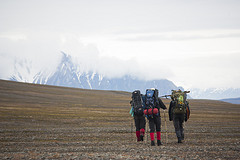
flic.kr/p/d3jWTS
Hiking without gear is similar to stepping up to the plate without a bat. Or perhaps, hitting the links without clubs. When you take to the trails without hiking gear, you’re merely tagging along while everyone else is having all the fun.
You really can’t hike properly without the correct gear. Hiking gear combines all of the essentials you’ll require to have a successful trek in the woods, and everything you’ll need to have fun with all the other kids.
Boots
First of all, if the trail isn’t all natural, it’s simply not hiking in the real sense. You need roots and rocks to fully experience a walk on the wild side. And, you also need a good pair of sturdy boots to help you handle the rough terrain. To find out whether a pair of boots is really sturdy, start at the bottom. Test out the feel of the soles. Remember that the boots you choose must protect your feet from debris and sharp rocks, and they need to provide enough ankle support to prevent sprains. Suffering a sprained or a twisted ankle is a definite possibility if you trip over a root or other obstacle along the trail. Hiking gear should be able to withstand not only the perils of the trail, but the dirt as well. If you don’t want to subject your white tennis shoe to the dirt, dust and mud of the great outdoors, you’d best leave them at home and choose a pair of boots that can stand up to whatever nature has to dish out.
Clothing
What you wear on the trail certainly has nothing to do with fashion. It’s all about protection and comfort. You need to know the weather condition, and potential temperature changes, before you set off on your hike. In fact, most hikers like to wear layers while on the trail. A t-shirt, sweater and lightweight vest or jacket will offer as much — or as little — warmth and protection as you require. When the sun is high and temperatures are warm, you can stuff the jacket into your pack and tie the sweater around your waist, and then put them back on when the sun begins to set. On the other hand, the inner layer of your clothing should be made of wicking fabric or another light material that will keep the sweat off of your body. The middle layer is usually for insulation. Lightweight polar fleece or high-tech knit sweaters are great choices.
Finally, cover up with a windproof and waterproof jacket. Wear sturdy pants to protect your legs from scratches and cuts. Bring at least one extra pair of socks, so that you change into a dry pair to avoid blisters.
Pack
A good pack is more than a place to carry your important hiking gear. It is usually part of your essential hiking gear. There are things you’ll need to bring on your hike, like extra clothing, water and food, and you’ll need to have ample room to carry them. Don’t commit the mistake of grabbing just any backpack from the department store shelves. Choose a proper hiking pack that has wide, padded straps, and a waist belt to aid with weight distribution. An improper pack can take its toll on your back, and simply ruin a great hike.
Insect Repellant
Even if you’re planning a solitary backwoods stroll, surely you won’t be alone. In fact, bugs are a necessary evil that hikers must deal with. Protect yourself from the discomfort, annoyance, and potential danger of bug bites by using a good quality insect repellant. Remember to bring the bottle along so you can ‘freshen up’ along the way.
The proper hiking gear can make or break your time on the trail. Pick the right gear and you’ll have a great time in the great outdoors.
Tagged with: hiking gear • mountain hiking
Filed under: Hiking Gear
